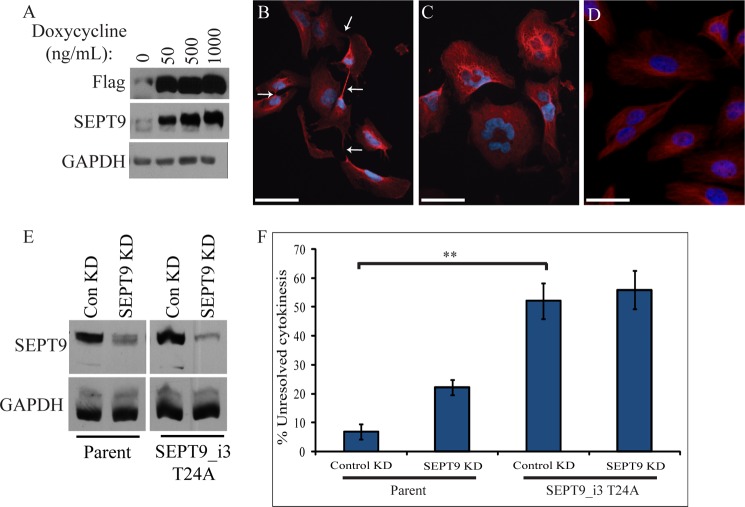FIGURE 7.
Expression of SEPT9_i3 T24A causes defects in cytokinesis. A, stable cell line inducibly expressing FLAG-SEPT9_i3 T24A was treated with increasing amounts of doxycycline, and expression was assayed by Western blotting with FLAG, SEPT9, and GAPDH antibodies. Note that FLAG-SEPT9_i3 T24A is expressed at low levels in the absence of doxycycline. B, expression of SEPT9_i3 T24A causes cytokinetic defects. Shown are representative examples of cells attached by persistent midbodies (in some cases to several cells) and (C) multinucleated cells following basal (uninduced) stable expression of siRNA-resistant SEPT9_i3 T24A (red, α-tubulin; blue, DNA). White arrows point to midbodies, which in some cases appear to have regressed. Scale bar represents 53 μm. D, Representative examples of the parent cell line used to generate the FLAG-SEPT9_i3 T24A cell line. Scale bar represents 53 μm. E, efficiency of SEPT9 depletion by siRNA. The parent and FLAG-SEPT9_i3 T24A cell lines were treated with control or SEPT9 siRNA. Lysates were probed for SEPT9 and GAPDH (all lysates were probed on the same blot). F, the parent and siRNA-resistant SEPT9_i3 T24A cell lines were treated with control or SEPT9 siRNA and assayed for defects in cytokinesis by immunofluorescence microscopy. Unresolved cytokinesis refers to cells exhibiting midbody attachment or multinucleation. Data are represented as mean ± S.E. (n ≥ 300 cells from 3 experiments); **, p < 0.005 (t test).

